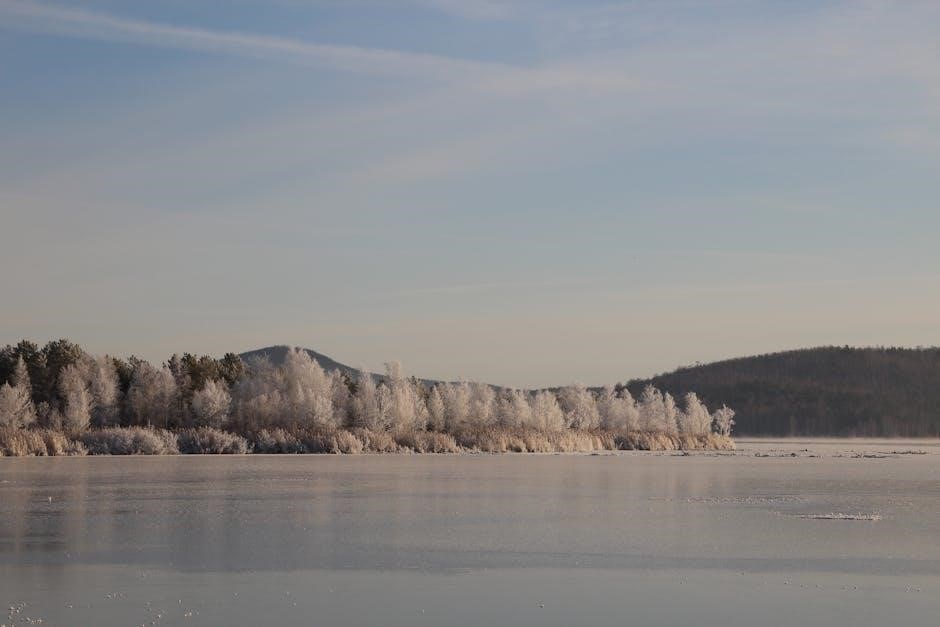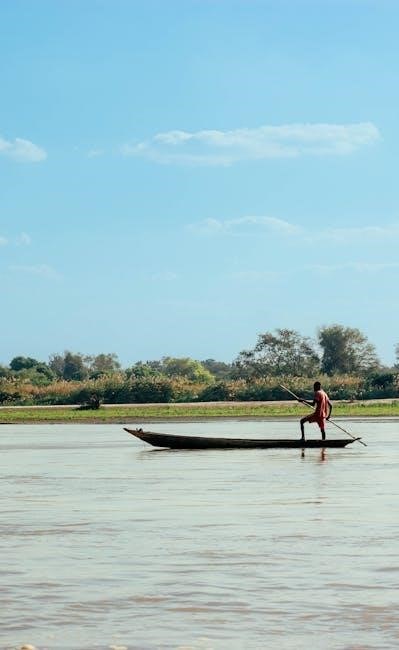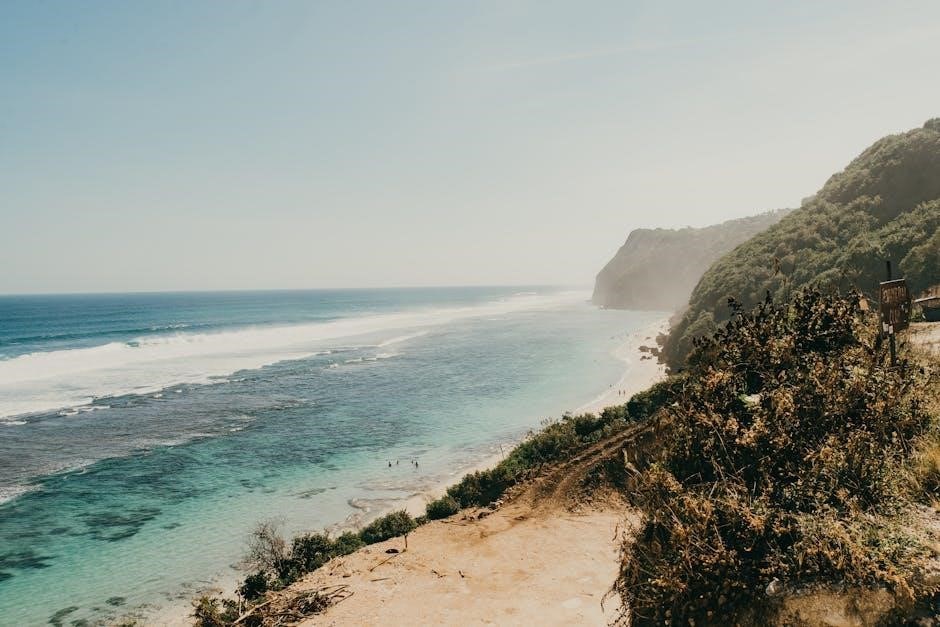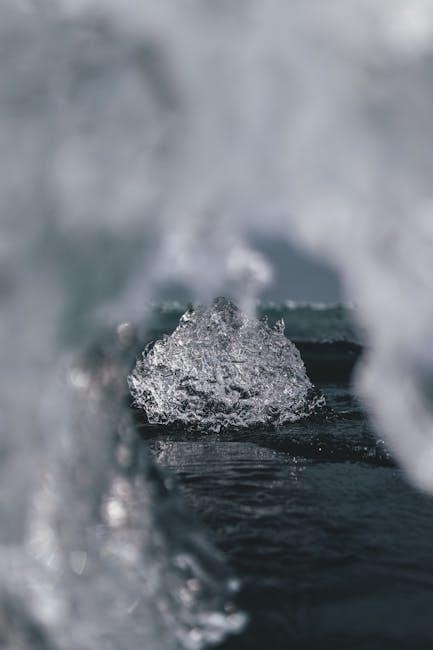Understanding water temperature is crucial for successful crappie fishing. Crappie are highly sensitive to temperature changes, influencing their location and behavior; This guide provides insights into how different water temperatures affect crappie, helping anglers locate and catch them effectively throughout the year.
Optimal Water Temperature Range

The optimal water temperature range for crappie fishing is generally considered to be between 55°F and 85°F (12°C to 29°C). Within this range, crappie exhibit varying levels of activity and can be found in different locations depending on the specific temperature. When water temperatures fall below 55°F, crappie tend to become more lethargic and less active, often retreating to deeper waters.
Conversely, when water temperatures rise above 85°F, crappie may become stressed and seek refuge in deeper, cooler areas of the lake or river. The most active and productive fishing typically occurs when water temperatures are within the 60°F to 75°F range. During this period, crappie are often more aggressive and actively feeding, making them easier to target with various fishing techniques.

Specifically, temperatures between 68°F and 72°F are often considered ideal, as this range coincides with the crappie spawning season and the post-spawn feeding frenzy. However, it’s important to note that these are general guidelines, and local conditions, such as water clarity and depth, can also influence crappie behavior and location.
Temperature Effects on Crappie Behavior
Crappie are highly sensitive to changes in water temperature, which significantly influences their behavior and activity levels. As water temperatures fluctuate throughout the year, crappie adapt by altering their feeding habits, preferred habitats, and spawning behavior.
In colder water, typically below 50°F, crappie become sluggish and conserve energy, often congregating in deeper areas with stable temperatures. Their feeding activity decreases significantly during this period. As water temperatures rise into the 50s and 60s, crappie become more active and begin to move towards shallower areas in preparation for spawning.
During the spawning season, when water temperatures reach the mid-60s to low-70s, crappie exhibit increased aggression and actively seek out suitable spawning locations. Male crappie will create nests in shallow water, while females move in to deposit their eggs. Post-spawn, crappie remain active as they feed heavily to recover energy. In warmer water, above 80°F, crappie may seek refuge in deeper, cooler areas to avoid excessive heat. Understanding these temperature-related behaviors is key to locating and catching crappie effectively.
Spawning Temperatures (62-67F)
The ideal water temperature for crappie spawning typically falls within the range of 62 to 67 degrees Fahrenheit. This temperature range triggers a series of behavioral changes in crappie, signaling the start of their reproductive cycle. As water temperatures approach this range in the spring, crappie begin migrating to shallower waters, seeking suitable spawning habitats.
Male crappie play a crucial role during spawning, actively preparing nests in areas with soft bottoms, brush piles, or gravel beds. These nests provide a safe and protected environment for the eggs to develop. Once the water temperature consistently holds within the 62-67F range, female crappie move into these nesting areas to deposit their eggs.
Spawning typically occurs in water depths of 2 to 8 feet, where the eggs are less vulnerable to predators and environmental factors. After the eggs are laid, male crappie diligently guard the nests, protecting them from potential threats until the eggs hatch. Anglers can take advantage of this spawning behavior by targeting shallow areas with suitable nesting habitats during this temperature range.
Spring and Summer Temperatures (65F to 75F)
During the spring and summer months, when water temperatures generally range from 65F to 75F, crappie exhibit active feeding behavior and can be found in various locations. As spawning concludes and water temperatures stabilize, crappie often transition to post-spawn patterns, remaining in shallower areas or moving to slightly deeper waters near structure.
In this temperature range, crappie are typically more active and willing to chase lures or baits. Look for them around submerged vegetation, brush piles, docks, and other forms of cover that provide shade and attract baitfish. These areas offer crappie ambush points and access to their primary food sources.
Anglers can effectively target crappie during the spring and summer by using a variety of techniques. Casting jigs, minnows, or small crankbaits around structure can entice strikes. Trolling slowly with these lures can also be productive, especially when searching for scattered crappie in open water. Adjusting the depth and presentation of your bait or lure based on crappie behavior is crucial for success in this temperature range.
Temperatures in the 40s
When water temperatures dip into the 40s, crappie behavior changes significantly. Their metabolism slows down, making them less active and more lethargic. During this period, crappie typically move to deeper waters, seeking warmer and more stable conditions. Locating them requires a shift in strategy, focusing on areas where they congregate to conserve energy.
Look for crappie in deep channels, creek mouths, and around submerged structures like standing timber or brush piles located in deeper sections of the lake or reservoir. They often hold tight to cover, minimizing their movements and waiting for opportunities to feed. During this time, crappie are likely to be in deep to mid-depth water and easing toward creeks and large coves.
Presenting baits slowly and precisely is crucial when targeting crappie in colder water. Use small jigs, live minnows, or other enticing offerings and present them near the bottom. Vertical jigging or slow-trolling techniques can be effective for covering water and locating concentrations of crappie. Be patient and persistent, as crappie may not be as aggressive as they are in warmer temperatures.
Temperatures in the 50s
As water temperatures rise into the 50s, crappie begin to transition from their deep-water winter haunts towards shallower spawning areas. This period marks a period of increased activity and feeding as they prepare for the upcoming spawn. Although not yet in full spawning mode, crappie become more active and start staging near potential spawning sites.

During this time, focus your efforts on mid-depth areas such as creek channels, points, and flats adjacent to spawning grounds. Look for structure like submerged trees, brush piles, or rock formations that provide cover and attract crappie. They are moving to the mid-depths and thinking about spawning/staging areas, so targeting these transition zones can be highly productive.
Crappie in the 50s are often more receptive to a variety of baits and presentations. Small jigs, minnows, and crankbaits can all be effective. Experiment with different retrieves and depths to determine what the crappie are responding to on a given day. Because temperatures in the 50s means stable fishing, patience is important to locate the fish and have a successful outing.
Temperatures Between 68 F to 72 F
When water temperatures reach 68°F to 72°F, crappie spawning activity typically peaks. This is a prime time for crappie fishing as both male and female crappie are concentrated in shallow spawning areas. Males will be actively guarding nests, making them aggressive and more likely to strike at lures or baits presented nearby. The best time to fish for crappie is when the temperature is about 68F to 72F.
Focus your fishing efforts on shallow areas with soft bottoms, brush piles, or gravel beds. Target depths of 2 to 8 feet, especially around submerged vegetation, docks, or other structures that provide cover. During this period, the crappie spawn time and post-spawn are at their peak. The best water temperature for crappie fishing is between 68 F to 72 F when the crappie spawn and post-spawn feed period seems to be at its highest point.
Effective baits and lures include small jigs, minnows, and crappie nibbles suspended under a bobber or retrieved slowly near spawning beds. Be mindful of disturbing the spawning beds and practice catch-and-release to help maintain healthy crappie populations. Remember, not all crappie will spawn at the same time, and some may be out in deeper water.
Water Temperatures Above 85F
When water temperatures climb above 85°F, crappie become stressed and seek refuge in deeper, cooler waters. Their metabolism slows down, and they become less active, making them more challenging to catch. During these hot summer months, crappie will be focusing on conserving energy within our lakes.
To target crappie in these conditions, focus your efforts on deeper areas near submerged structure, such as creek channels, humps, or ledges. Look for areas with shade or cooler water temperatures, such as those created by submerged trees or vegetation. Crappie will be holding tight to bottom cover in 30-50 feet deep and tight-lipped, but they still need to eat and is catchable. You should be able to find them suspended within the water column of deep channels or hugging the mud.

Use heavier weights to get your bait or lure down to the desired depth, and fish slowly and methodically. Live bait, such as minnows or worms, can be effective, as can slow-moving jigs or crankbaits. Be patient and persistent, as crappie may not be actively feeding. While crappie prefer warmer water temperatures of 60, 70, or even 80F, they will become fairly inactive once the water temperature goes above 85F.
Black vs. White Crappie Spawning Temperatures
While both black and white crappie generally spawn in similar conditions, some subtle differences in their preferred water temperatures can influence their behavior and location during the spawning season. White crappie tend to spawn in slightly warmer water compared to black crappie. Generally, white crappie may begin spawning activity when water temperatures reach the lower end of the 60s (Fahrenheit), while black crappie often prefer temperatures in the mid to upper 60s.
This preference can lead to some spatial separation during the spawn, with white crappie potentially utilizing shallower, sun-warmed areas earlier in the season. Black crappies can usually be counted on to spawn deeper than white crappies. Anglers can use this information to target specific species based on water temperature and location. For example, in early spring, focusing on slightly deeper areas might yield more black crappie, while fishing shallower, warmer spots could be more productive for white crappie.
Keep in mind that these are general trends, and individual fish behavior can vary. Other factors, such as habitat availability and water clarity, also play a role in spawning site selection. When crappie are spawning and feeding after spawning, the optimal water temperature for fishing is between 68 F and 72. Some crappie will be out in deeper water and some will be closer to the banks during spawning.
Location Guidelines Based on Temperature
Water temperature is a key factor in determining where crappie are located throughout the year. As temperatures change, crappie migrate to find their preferred conditions. In colder months, when temperatures drop into the 40s, crappie seek deeper water, often near structures like submerged trees or creek channels. As the water warms into the 50s, they begin to move towards shallower staging areas near spawning grounds, such as the mouths of creeks and coves.
During the spawning season (62-67F), crappie move into very shallow water, often less than 8 feet deep, seeking out brush piles, gravel beds, or soft bottoms to build nests. When temperatures reach 65F to 75F, crappies prefer these warmer waters during spring and summer. After spawning, as temperatures rise into the 70s and 80s, crappie often retreat to deeper, cooler water near thermoclines or shaded areas. Fishing deeper channels may be fruitful when temperatures hit 90 degrees.
Knowing these temperature-related movements can significantly improve your fishing success. Using a thermometer to monitor water temperature and adjusting your fishing location accordingly is a valuable strategy. Remember to also consider other factors like water clarity, sunlight, and available cover when selecting your fishing spot.
Weather Conditions and Temperature Stability
Weather conditions play a pivotal role in influencing water temperature and, consequently, crappie behavior. Stable weather patterns, particularly warm spells, generally lead to more consistent water temperatures, which can make crappie fishing more predictable. Under these conditions, crappie are often more active and feed more aggressively, making them easier to catch. Conversely, sudden changes in weather, such as cold fronts or heavy rainfall, can cause rapid fluctuations in water temperature, impacting crappie behavior.
Cold fronts, in particular, can cause crappie to become lethargic and less likely to feed, leading them to seek deeper water. The sudden drop in temperature can shock their system, reducing their activity levels. Heavy rainfall can also affect water temperature, especially in smaller bodies of water. Rain can cool the surface water and increase turbidity, making it harder for crappie to see and feed. Stable, warm weather often leads to better catches, as crappie are more active. Understanding these impacts is key to timing your fishing trips for optimal results.
Monitoring weather forecasts and paying attention to recent weather patterns can provide valuable clues about water temperature stability and its likely impact on crappie.


